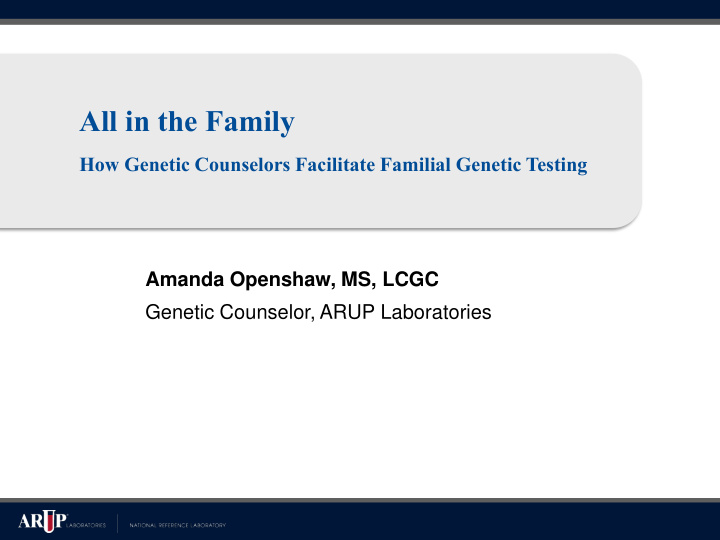



All in the Family How Genetic Counselors Facilitate Familial Genetic Testing Amanda Openshaw, MS, LCGC Genetic Counselor, ARUP Laboratories
Objectives • Recognize different methodologies for performing family specific genetic testing • Explain why positive control samples and a proband’s original test report are important for accurate testing • Identify how genetic counselors can serve as a resource during the familial testing process
Why This Topic is Important • Potential for false reassurance of a normal result – If we didn’t know what we were looking for or how to look for it, the family member may still be at risk. • Original proband’s report, or providing a positive control is important but can take effort – Best to be prepared prior to testing family members
Why do Familial Testing? • Medical management and recurrence risks • Some OHPs opt for the SAME test as the proband – Targeted, site-specific testing is often cheaper and faster than the more comprehensive version that the proband had – Especially when dealing with NGS panels, or genomic microarray, it’s a better use of healthcare dollars to go searching only in the region with a genetic change • Assumes you know how the proband was tested… • Assumes you know exactly where to look…
Types of Proband Test Results • Single gene testing – Gene(s) sequencing (Sanger or NGS panel) – Single gene del/dup testing • Genomic testing – FISH – Microarray – Chromosome analysis – (Exome sequencing)
Familial Genetic Tests • Recommended test to order on family members depends on several factors – How the proband was tested and what the results were – Clinical question for the family member – carrier status? Affected status? Recurrence risk? • Methodology used for proband’s testing may not be appropriate for a family member • There may be more than one option for familial testing each with pros and cons
Test Selection (sometimes) PROBAND FAMILY MEMBER Sequencing Sequencing del/dup (MLPA) del/dup (MLPA) FISH FISH Array Array Chromosomes Chromosomes
Testing Selection (more common) PROBAND FAMILY MEMBER Sequencing Sequencing del/dup (MLPA) del/dup (MLPA) FISH FISH Array Array Chromosomes Chromosomes
Brief Overview of Test Methods – Sequencing Targeted mutation/exon Modified from slide by Yuan Ji, PhD
Sequencing Full-gene Modified from slide by Yuan Ji
MLPA http://www.mrc-holland.com http://www.mrc-holland.com
FISH
Genomic Microarray www.affymetrix.com Image courtesy of Affymetrix.
Genomic Microarray www.affymetrix.com Images courtesy of Affymetrix.
Chromosome Analysis http://www.spectral-imaging.com
So many options – now what? PROBAND FAMILY MEMBER Sequencing Sequencing del/dup (MLPA) del/dup (MLPA) FISH FISH Array Array Chromosomes Chromosomes • Ask a genetic counselor to help select and coordinate testing!
Genetic Counselor’s Role • Test selection – Implication of results • Test coordination – Obtaining reports, paperwork, and making sure lab is informed – Checking that family member and control samples are ordered correctly • Interpretive comments • Informing OHP about results
Proband Reports / Positive Controls • Proband report and positive control are both important • Controls ensure the test ordered would have identified the familial variant if present – Lab methodologies can be slightly different – Nomenclature for mutations can be different – Some familial testing might be possible without a control • Control options: – Proband’s previous sample – New blood or buccal sample from proband – Maternal blood for fetal tests
Summary - Suggestions • Involve genetics / genetic counselors • Be prepared to obtain a report • Investigate sooner rather than later – May avoid a proband redraw
Objectives • Distinguish different methodologies for performing family specific genetic testing • Explain why positive control samples and a proband’s original test report are important for accurate testing • Understand how genetic counselors can serve as a resource during the familial testing process
Acknowledgements • Erin Baldwin, MS, CGC • Sara Brown, MS, CGC • Shelly Bosworth, MS, CGC • Yuan Ji, PhD, DABCP, FACMG • Fellow ARUP GCs, Medical Directors • ARUP Genetics Division Labs and non-genetics personnel participating in this testing
Recommend
More recommend